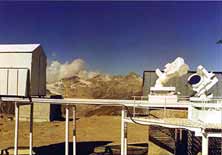| Terskol Peak
is a spur of Elbrus mountain. It has altitude 3100 m
and coordinates 43°13'N, 2h50mE.
The ATsU-26 telescope was established there in 1989. The telescope
is equipped with 5-camera spectrograph, thus it allows s imultaneous
observations in five spectral regions. Diameter of the main
spherical mirror is 650 mm, focal length - 17750 mm;
diameter of the collimator and cameras - 300 mm, focal
length - 8000 mm; grating - (250*200) mm, 600 lines/mm;
dispersion in fourth order - 21.9 mm/nm at 395.0 nm,
33.0 mm/nm at 650.0 nm. The telescope scheme is
shown on the right figure. imultaneous
observations in five spectral regions. Diameter of the main
spherical mirror is 650 mm, focal length - 17750 mm;
diameter of the collimator and cameras - 300 mm, focal
length - 8000 mm; grating - (250*200) mm, 600 lines/mm;
dispersion in fourth order - 21.9 mm/nm at 395.0 nm,
33.0 mm/nm at 650.0 nm. The telescope scheme is
shown on the right figure. | 








